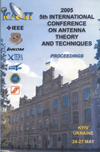Antennas for concealed weapon detection
DOI:
https://doi.org/10.1109/ICATT.2005.1496885Keywords:
weapon detectionAbstract
Concealed knives, pistols and bombs that might be brought or attempted to be brought into private, commercial, industrial, public, governmental or military facilities with the intent to commit terrorist or illegal acts are of concern [1-3].
An approach presented incorporates circularly polarized, focused antenna arrays to produce very small common (transmit–receive) antenna beam footprints on the suspect under surveillance. Signal processing using the Fourier or a Wavelet Transform (in the preferred methodology) to detect and discriminate concealed weapon types or categories.
Transmitting of the RF signals can be continuous, can be switched on and off manually, or can be automatically triggered by some other system when an individual enters the surveillance zone (such as an ultrasonic radar, light beam, etc.) The apparatus can be fixed in a facility being protected or made portable and operated from either AC or DC power.
References
KNUTSON, W.; KOZAKOFF, D.J. Concealed Weapon Detection. Final Report on Phase I SBIR contract ED-01-PO-3721, US Department of Education, Washington, DC, March 2002.
KOZAKOFF, D.J.; KNUTSON, W. Concealed Weapons Detection. Phase II SBIR Final Report for the US Department of Education, Washington, D.C., Contract ED-02-CO-0046, September 2004.
KOZAKOFF, D.J.; ET AL. Method of Long Range Concealed Weapon and Bomb Detection. US Pat. Pending, 2004.
LI, XU; HAGNESS, S.C. A conformal microwave imaging algorithm for breast cancer detection. IEEE Microwave and Wireless Components Letters, Mar. 2001, v.11, n.3, p.130-132, doi: http://dx.doi.org/10.1109/7260.915627.
WANG, J.J.H.; TRIPP, V.K. Design of multioctave spiral-mode microstrip antennas. IEEE Trans. Antennas and Propagation, Mar. 1991, v.39, n.3, p.332-335, doi: http://dx.doi.org/10.1109/8.76330.
LEWIS, L.R.; FASSETT, M.; HUNT, J. A broadband stripline array element. IEEE AP-S Symp. Digest, Atlanta, GA. IEEE, 1974, v.12, p.335-337, doi: http://dx.doi.org/10.1109/APS.1974.1147206.
GIBSON, P.J. The Vivaldi Antenna. Proc. of 9th European Microwave Conf., 17-20 Sept. 1979, Brighton, UK. IEEE, 1979, p.101-105, doi: http://dx.doi.org/10.1109/EUMA.1979.332681.
CHIO, TAN-HUAT; SCHAUBERT, D.H. Parameter study and design of wide-band widescan dual-polarized tapered slot antenna arrays. IEEE Trans. Ant. Prop., June 2000, v.48, n.6, p.879-886, doi: http://dx.doi.org/10.1109/8.865219.
BILLINGSLEY, J.B. Low-Angle Radar Land Clutter. Measurements And Empirical Models. William Andrew Publishing & SCITECH Publishing & IEE, 2002.
MULLER, H.J.; Characterization of radar clutter by gamma induced distributions. Proc. of Geoscience and Remote Sensing Symp., 6-10 Jul. 1998, Seattle, WA. IEEE, 1998, v.3, p.1216-1218, doi: http://dx.doi.org/10.1109/IGARSS.1998.691355.
RUIJUN, DONG; ZHENG, E. Direct data domain STAP algorithm for airborne radar applications. Proc. of CIE Int. Conf. on Radar, 15-18 Oct. 2001, Beijing. IEEE, 2001, p.770-772, doi: http://dx.doi.org/10.1109/ICR.2001.984827.
ONSTOTT, R.G. Study of the polarization behavior of complex natural and man-made clutter at middle and grazing angles. Proc. of Geoscience and Remote Sensing Symp., 6-10 Jul 1998, Seattle, WA. IEEE, 1998, v.5, p.2587-2589, doi: http://dx.doi.org/10.1109/IGARSS.1998.702287.
SAKAR, T.K.; ET AL. Wavelet Applications. Boston, MA: Artech House, 2002.
CHUI, C.K. An Introduction to Wavelets. San Diego, CA: Academic Press, 1992.
ROTMAN, W.; TURNER, R. Wide-angle microwave lens for line source applications. IEEE Trans. Ant. Prop., Nov. 1963, v.-11, n.6, p.623-632, doi: http://dx.doi.org/10.1109/TAP.1963.1138114.
ARCHER, D. Line Fed Multiple-Beam Arrays. Microwave Journal, Sept. 1984, p.175-195.
SCHINDLER, J.K.; MACK, R.B. (eds.). The Modification of Electromagnetic Scattering Cross Sections in the Resonant Region. A Symposium Record, Vol. 1. Air Force Cambridge Research Laboratories Report AFCRL-64-727, Hanscom Field, MA, September 1964, p.6.
SEVICK, J. Experimental and Theoretical Results on the Back-Scatter Cross Sections of Coupled Antennas. T.R. No. 150, The Cruft Laboratory, Harvard University, Cambridge, MA 1952.

